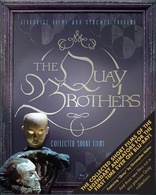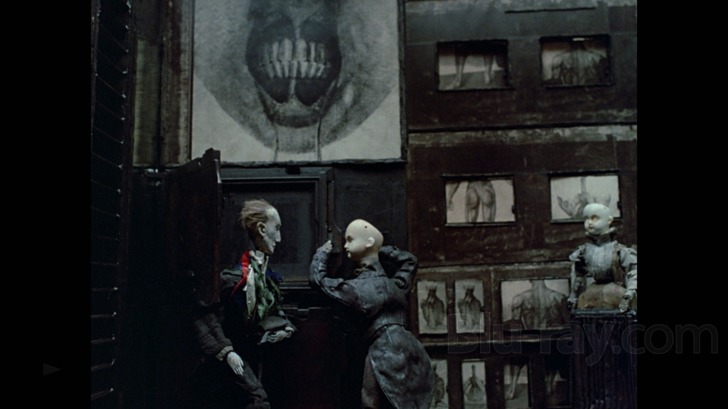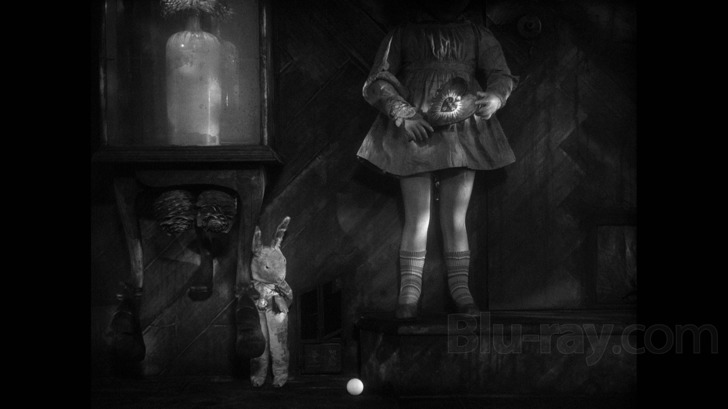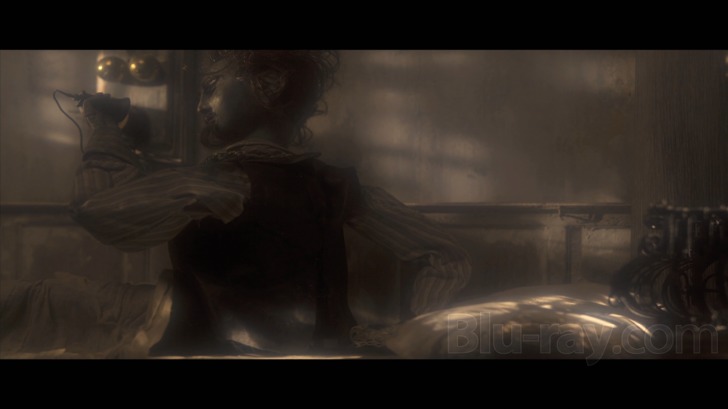The Quay Brothers: Collected Short Films Blu-ray Movie
HomeThe Quay Brothers: Collected Short Films Blu-ray Movie 
Zeitgeist Films | 1984-2015 | 230 min | Not rated | Nov 24, 2015
Movie rating
7.9 | / 10 |
Blu-ray rating
| Users | 0.0 | |
| Reviewer | 4.0 | |
| Overall | 4.0 |
Overview
The Quay Brothers: Collected Short Films (1984-2015)
THE CABINET OF JAN ŠVANKMAJER (1984) <br> THIS UNNAMEABLE LITTLE BROOM (1985) <br> STREET OF CROCODILES (1986) <br> REHEARSALS FOR EXTINCT ANATOMIES (1987) <br> STILLE NACHT I-IV (1988-94) <br> THE COMB (1990) <br> ANAMORPHOSIS (1991) <br> IN ABSENTIA (2000) <br> THE PHANTOM MUSEUM (2003) <br> MASKA (2010) <br> THROUGH THE WEEPING GLASS (2011) <br> UNMISTAKEN HANDS (2013) <br> QUAY a film by Christopher Nolan (2015)
Director: Stephen Quay, Timothy Quay| Surreal | Uncertain |
| Short | Uncertain |
| Animation | Uncertain |
Specifications
Video
Video codec: MPEG-4 AVC
Video resolution: 1080p
Aspect ratio: 1.37:1, 1.78:1, 2.35:1
Original aspect ratio: 2.35:1, 1.85:1, 1.37:1
Audio
English: DTS-HD Master Audio 2.0 (48kHz, 24-bit)
Subtitles
English SDH
Discs
50GB Blu-ray Disc
Single disc (1 BD)
Packaging
Slipcover in original pressing
Playback
Region A (B, C untested)
Review
Rating summary
| Movie | 4.0 | |
| Video | 4.5 | |
| Audio | 4.5 | |
| Extras | 2.5 | |
| Overall | 4.0 |
The Quay Brothers: Collected Short Films Blu-ray Movie Review
Such Stuff as Dreams Are Made Of
Reviewed by Michael Reuben November 27, 2015For anyone already familiar with the work of the Quay Brothers, no introduction is necessary. For
those new to this idiosyncratic world, no introduction can prepare you, but here are some
background facts. Stephen and Timothy Quay are twin brothers, now 68, who began as
illustrators, then moved into animation, feature films and set design for the performing arts. Born
in Norristown, Pennsylvania, the Quays studied at the Philadelphia College of Art, then moved to
London in 1969 to continue their studies at the Royal College of Art. They have remained in
London ever since, forming Koninck Studios with their producer, Keith Griffiths. Their work
straddles film, theater and fine arts so that you are just as likely to find them at a film festival or
designing a set for Broadway as at an exhibit of their work at a major museum.
The Quays' short films have an occasional live actor, but they are almost entirely populated by
puppets animated by the stop-motion technique of shooting a single frame at a time. The Quays
typically make their figures from old doll parts and other "found" materials, and their stories are
(to put it mildly) non-linear. They draw inspiration from a range of obscure sources, many of
them Eastern European and Latin American, and most of them unknown to mainstream Western
audiences. As the commentaries on this Blu-ray confirm, the Quays work intuitively, and the
resulting products have the intricate but inexplicable texture of a dream. In the accompanying
essay, director Christopher Nolan recalls his first encounter with a Quay animation while channel
surfing as a teenager. It gripped his imagination for reasons he could not explain and inaugurated
a life-long obsession that ultimately resulted in the publication of this Quay collection through
Nolan's production company, Syncopy Films.

The Austrian philosopher Ludwig Wittgenstein, who was rigorous in his demands for linguistic precision, famously declared: "Whereof one cannot speak, thereof one must be silent." Wittgenstein was addressing comprehensive issues of ethics and aesthetics, but he might also have been speaking of the Quay Brothers and their work. As Michael Atkinson says in an essay accompanying this Blu-ray release, discussions among Quay fans typically devolve into exchanges of "thoughtful nodding"—and little else. Except in the most reductionist terms, the Quays' work defies description. It bypasses the logical part of our consciousness, where experience and perception are ordered and structured, and connects directly to that mysterious realm that Freud called "the unconscious", where ordinary logic no longer prevails. Images and sounds fit together in a manner that feels coherent, but for reasons outside the boundaries of rational thought. Try to explain the connections, and you quickly become tongue-tied. You can listen to the Quays explain where some of the images came from, as they do on this Blu-ray's commentary tracks, but that doesn't capture the experience of watching the films.
The films are presented in chronological order. They can be selected individually or played in one continuous sequence. A few words about each:
- The Cabinet of Jan Švankmajer (1984) (1.37:1; 14:13): This is the Quays' tribute to the Czech animator and graphic artist whose surrealistic style has often been compared to theirs, although they developed their approach independently. A master craftsman "trains" an apprentice by filling his head (literally) with knowledge. Pins play a major role.
- This Unnameable Little Broom (1985) (1.37:1; 11:13): This work was originally conceived as part of a one-hour project that would also encompass other media, including dance. As noted in the opening titles, the project was loosely based on the Babylonian legend of Gilgamesh, although it is difficult to spot the connection, even after listening to the Quays' commentary. When the BBC saw this completed segment, the funding for the larger project was canceled.
- Street of Crocodiles (1986) (1.37:1; 21:26): This is the short film that a teenaged Christopher Nolan chanced upon during a late night TV broadcast. It begins in black and white with the real figure of an elderly man entering a theater or workshop, where he activates a machine by spitting into it. Inside the machine, the world is mechanical and in color: a succession of processes involving strings, screws, rubber bands and jointed concoctions, all of them endowed with a life of their own.
- Rehearsals for Extinct Anatomies (1987) (2.35:1; 14:31): Interpreting the intertitles for a Quay Brothers film is a risky endeavor, but the playful dedication of this work to the London Underground may have something to do with its recurrent visual motif of vibration, a phenomenon familiar to any resident of a city with an extensive subway system. Some of the effects are quite magical, e.g., a bar code in which individual bars seem to pulse with life. Nearly every frame has some such element, often vibrating so rapidly that it seems to pull the camera out of focus.
- Stille Nacht I: Dramolet (1988) (1.37:1;1:49): In this short created for MTV, a lone figure watches fuzz accumulate outside a window like snow.
- The Comb (1990) (1.85:1; 18:05): Subtitled "From the Museums of Sleep", this short uses distorting lenses, forced-perspective models and drawings, whispered words on the soundtrack and a host of other devices to create the Quay version of a fairy tale forest realm. The comb of the title is part of the live-action black-and-white sequence that bookends the film.
- Anamorphosis (1991) (1:37:1; 14:20): Commissioned by the Program for Art on Film, this short feature uses animation to explore the artistic phenomenon of "anamorphsis", which involves hiding images in visual works of art by distorting them so that they cannot be seen unless the work is viewed from a specific angle. Narrated by Witold Scheybal, with optional English SDH titles.
- Stille Nacht II (Are We Still Married?) (1992) (1.37:1; 3:28): An evocative "music video" for a song by the American rock band His Name Is Alive. It stars a child's stuffed rabbit.
- Stille Nacht III (Tales from Vienna Woods) (1993) (1.37:1; 4:19): "In death have I blossomed", reads the legend engraved on a heart-shaped figure. A gun fires, and the camera traces the bullet's path through a surreal landscape.
- Stille Nacht IV (Can't Go Wrong Without You) (1994) (1.37:1; 3:58): Another "music video" for His Name Is Alive featuring the same stuffed rabbit, but now pursued by a death's head figure bearing a unicorn-like horn.
- In Absentia (2000) (2.35:1; 20:09): Inspired by a collection of "outsider art" (i.e., art by people diagnosed with psychosis), this film evokes a paranoid and hopeless landscape worthy of Kafka.
- The Phantom Museum (2003) (1.78:1; 11:50): The opening text—"Random forays into the vaults of Sir Henry Welcome's medical collection"—sounds vaguely sinister, but the exhibits initially resemble children's toys allowing them to minister to ailing dolls. Gradually, though, the demonstrations take on a more adult and darker character. By the end, the boundaries between human and machine have been effectively blurred.
- Maska (2010) (1.78:1; 24:29): Based on the short story "The Mask" by Stanislaw Lem (who wrote the novel Solaris), this film centers on a woman who awakens to consciousness, with no awareness of herself or her past. Forced English subtitles translate the Polish voiceover narration.
- Through the Weeping Glass (2011) (1.78:1; 31:26): "This film is a meditation on the Medical Collection housed in The College of Physicians of Philadelphia." The film offers a tour of some of the most unusual and (it should be noted) disturbing exhibits, using traditional photography rather than stop motion. Narrated by Derek Jacobi, with optional English SDH titles.
- Unmistaken Hands (2013) (2.35:1; 26:06): A fanciful portrait of Uruguayan writer Felisberto Hernández, considered to be the founder of "magical realism". Forced English subtitles translate the Spanish voiceover narration.
- Quay: A Film by Christopher Nolan (2015) (1.78:1; 8:21): Nolan's camera observes the Quays laboring in their workshop, surrounded by cameras, puppets, illustrations, books and random objects. They describe their techniques and demonstrate how they manipulate the puppets and operate the camera.
The Quay Brothers: Collected Short Films Blu-ray Movie, Video Quality 

A note in the accompanying booklet entitled "About the Transfers" reads as follows:
The films on this Blu-ray are presented in the highest possible quality from film-to-digital transfers made under the personal supervision of the Quay Brothers. The characteristic film grain, instability and flicker associated with the stop-motion technique has been retained, whilst removing the unintentional artefacts of dirt, sparkle and scratches that are a product of film handling and aging (although taking care not to "correct" intentional blemishes). All films are presented in the Quays' originally intended aspect ratios.
As suggested by the reference to "instability" and "flicker", many of the criteria by which we typically evaluate Blu-ray transfers are difficult to apply to Quay productions, because of their deliberate stylization, a quality that becomes even more pronounced when the films are viewed in motion. Still, it is evident that great care has been taken to extract a high-quality image from the available sources, because the figures and backgrounds have the weight and density for which stop-motion animation is justly prized. The visible detail in the puppet figures and in their surroundings is remarkable. With rare exceptions, colors in the Quay world tend to be faded and "antique", but these shadings have been delicately rendered. The one thing that these presentations certainly do not look is digital. The Quay Brothers style evolved in an analog world, and the Blu-ray presentation preserves that look.
Zeitgeist Films has mastered the collection with an overall average bitrate of 23.95 Mbps, although this figure is somewhat misleading. Depending on the demands of the particular short film, the average for each entry ranges from just under 22 to over 34 Mbps. Each film obviously presented different demands for compression, and it appears that each one was evaluated and processed individually.
The Quay Brothers: Collected Short Films Blu-ray Movie, Audio Quality 

Every film has a two-channel track encoded as lossless DTS-HD MA 2.0, but some are mono with identical left and right tracks, while others are stereo with clear and precise separations in both the musical accompaniment and the background voices that are a frequent element of a Quay Brothers soundtrack. Although Quay films dispense with dialogue, narration occurs frequently, sometimes in English, sometimes in another language accompanied by English subtitles. Background voices are often heard that are not meant to be understood, speaking either gibberish or a mixture of languages. The Quays prefer to use non-melodic music from avant garde composers such as Karlheinz Stockhausen or Zdenek Liška. They have made exceptions for music videos for the band His Name Is Alive. In some cases, the recordings have been made to sound like old phonograph records.
The Quay Brothers: Collected Short Films Blu-ray Movie, Special Features and Extras 

- Commentaries: The commentaries are selectable from a single menu.
- This Unnameable Little Broom (1985)
- Street of Crocodiles (1986)
- Stille Nacht I: Dramolet (1988)
- Stille Nacht II (Are We Still Married?) (1992)
- Stille Nacht III (Tales from Vienna Woods) (1993)
- In Absentia (2000)
- Booklet: The included booklet is comprised of "The Quay Enigma", an essay by Christopher Nolan; "The Decaying Warehouse of Fears and Forgetfulness", an essay by writer and editor Michael Atkinson; disc credits and acknowledgements; and an invaluable "Quay Brothers Dictionary" by Michael Brooke, expanded and updated from his original version published with the BFI's DVD compilation of the Quay Brothers' short films.
The Quay Brothers: Collected Short Films Blu-ray Movie, Overall Score and Recommendation 

I had only seen a few Quay cartoons before reviewing this collection. Having now watched a
large number in a short time, I feel like I need time to recover. The Quay Brothers work slowly
and deliberately, and their output should be consumed the same way, letting this or that
individual production slip into one's subconscious and set off whatever chains of association it
happens to detonate. The "Collected Short Films" are a set to be taken down from the shelf every
so often, sampled briefly, and then returned to a safe place until the viewer is ready for more.
Now that they're available at this level of quality, their power is even more evident. Not for
everyone, but highly recommended for those who are so inclined.
Similar titles
Similar titles you might also like

Meshes of the Afternoon
1943

Masterworks of American Avant-Garde Experimental Film 1920-1970
1920-1970

Meditation on Violence
1949

At Land
1946

Les 3 boutons
2015

T'as de beaux escaliers, tu sais
You've Got Beautiful Stairs, You Know
1986

7 p., cuis., s. de b., ... (ŕ saisir)
1984

The Pass
1988

The Return
1980

The Witch's Cat
1929

A Study in Choreography for Camera
1945

Ritual in Transfigured Time
1946

Altered Innocence Vol. 2
Slipcover in Original Pressing
2023

Le 15/8
1973

The Girl Without Hands
La jeune fille sans mains
2016

Animation Express
2005-2009

Blood Tea and Red String
2006

Technicolor Dreams and Black & White Nightmares
1917-1947

I Married a Strange Person!
1997

A Hollis Frampton Odyssey
1966-1979